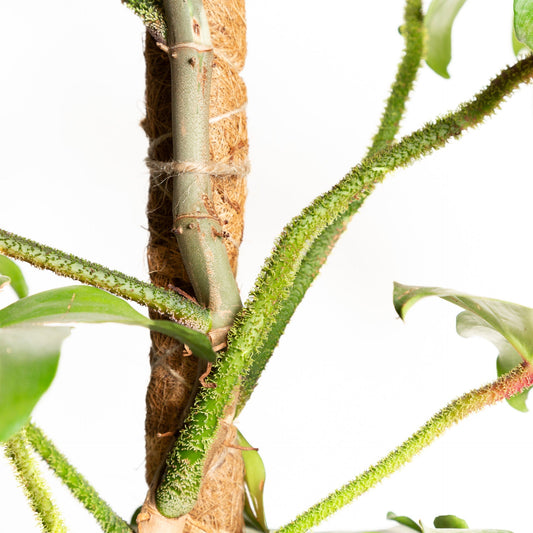The flourishing growth of summer may make plant care extra rewarding, but Fall offers us an opportunity to slow down and celebrate all of the progress we made. As the temperatures drop and the light begins to wane, our plants slow down as well - sometimes (although not as often as you might expect) even going into dormancy. That doesn’t mean it’s time to go on auto-pilot though.
Fall plant care is almost like tucking your plants in for the winter. By being attentive to their shifting needs, you can prevent stress and damage so they can reserve more energy for next years growing season.
How Fall impacts your houseplants
While many of us look forward to the coziness of “sweater weather”, Fall’s waning light and dipping temperatures can be a source of stress for your plants. Many plants are used to changing seasons and can adjust to gradual shifts, but sudden or dramatic changes can cause lasting damage to your plant’s health. Here’s what you need to know to help ease your plant into this new season.
How often should you water your plants in the fall?
One common misconception is that the best way to water plants is on a schedule. Sunday rolls around and you grab your watering can, ready to give all of your plants a drink. In reality the best thing you can do for your plants is to adopt a “check your soil” schedule.
This means using your finger or a wood chopstick to check on the moisture in your plants soil to see if it has reached the desired level of dry out. How often you water your plants should depend on how quickly your soil dries.
As the heat decreases and your plant’s growth slows, you will likely notice it takes slightly longer for your soil to dry than it did during the hot and verdant summer months. However, it is always best to let the soil show you how frequently or infrequently you need to water.
Supplement Low Light with Grow Lights
In the Pacific Northwest (where the Urban Sprouts Store is situated) we’re known for our dreary…well…most of the year actually. Not only do our days shorten, but consistent cloud cover means weeks can go by between sun sightings. If PEOPLE have lamps to help supplement their light, chances are good your plants would benefit from a grow light as well.
Grow light bulbs come in a variety of styles now that can easily and unobtrusively be set up to help supplement your plant’s needs. While grow lights do not provide the same intensity of direct sun, it is still important to gradually introduce them into you plant's environment.
It is also important to be aware of the heat the bulb gives off. While newer options don’t produce as much heat as other grow lights, it is still best to keep them between 12” and 30” from the crown of your plant.
Plugging your lights into a timer also makes it easy to maintain consistency. While we might be used to having lights on for 12 hours of our day, your plant’s do best when the lights mimic the natural cycles of the sun.

Outside temperature drops can still affect your plants indoors.
Many houseplants are tropical plants that prefer temperatures between 60 to 80 degrees. Since that’s within the range most people keep their homes, most of the time that works out fine. However, sudden cold snaps can still shock an unsuspecting plant. Blasts of cold hair from uninsulated or drafty windows and outside doors can shock or even kill your house plant if left unattended for too long.
Before the weather changes, pay attention to the placement of your plants. Can you feel a chill from the window when the temperature cools at night? Are they right in the path of a heating vent? Do the leaves rustle every time you come in from outside? If you can, shift your plants before any cold snaps so they aren’t in the direct path of any temperature extremes.
If the foliage of your plants isn't particularly sensitive to drafts, a windowsill heating mat can help protect the roots of your plants from suffering any adverse effects from the cold.
Signs of temperature shock
If you’ve been watering consistently but notice leaves starting to droop, curl, or change color, you are likely seeing the signs of temperature shock. If this happens, move your plant to a warmer location immediately (remembering not to put it directly in the path of heating vents or radiators).
If your plant suffered from acute cold, there are some steps you can take to give it the best chance to revive.
Gently pour a small amount of water into your plant’s soil. When plants experience a chill they lose some of their moisture, so water helps your plant rehydrate and as well as slightly raising the temperature of the soil. This isn’t a full watering, however, just a small sip. Bring your plant by our clinic or schedule a virtual consultation if symptoms are severe.
How Fall weather impacts indoor humidity.
Maintaining a consistent temperature is important for your plants long term health, but the dry air circulated by your heater can lower your humidity which can create challenges of it’s own.
Many popular houseplants evolved in tropical environments, and the closer you can mimic it’s endemic conditions the happier they will be. There are a variety of ways you can increase the humidity around your plants like pebble trays, micro misters, humidifiers, and grouping plants together. The right humidity solution for you is one that fits both your routine and your environment.
A lack of humidity can also be attractive to foliage pests like spider mites, who prefer dry heat to wet heat. We recommend checking your plant thoroughly once a month, and cleaning your leaves as a preventative measure once a season.
Fertilizing your plant in the Fall
If you are using commercial fertilizer, it’s important to wean your plant off of it during the Fall months. As your plant’s growth slows, it will have less need for the nutrients in a commercial fertilizer, which can result in build up in the soil and even root damage.
We recommend using a bacterial inoculant rather than a fertilizer. It’s helps your soil maintain it’s healthy bacteria which will then provide nutrients for your plant naturally. Not only will maintaining your bacterial inoculant NOT hurt your plant, it also ensures your plant has access to any nutrients it might need to help recover from stress and, come spring, your plant will have everything it needs to thrive.

Enjoy the coziness.
As your plant slows down, it’s a wonderful reminder to slow down yourself. Celebrate the ways you and your plants have grown during the bountiful summer months.
It’s a great time to do a thorough clean up of your plant’s space by dusting leaves and wiping down pebble trays and saucers and removing dead leaves.
Re-arranging your plants to help them avoid drafts and vents is also a wonderful opportunity to redecorate your space. A beautiful new plant hanger or plant stand can help make a room that much more comfy (and makes room for more plants).
If you’ve got specific questions about how to prepare your plants for the fall, or you are concerned your plant is suffering from cold shock, don’t hesitate to reach out to us for help. You can book an in person or Digital Diagnostic for a thorough examination of your plant and personalized care suggestions, or for quick questions reach out to us on Instagram at @UrbanSproutsStore.



